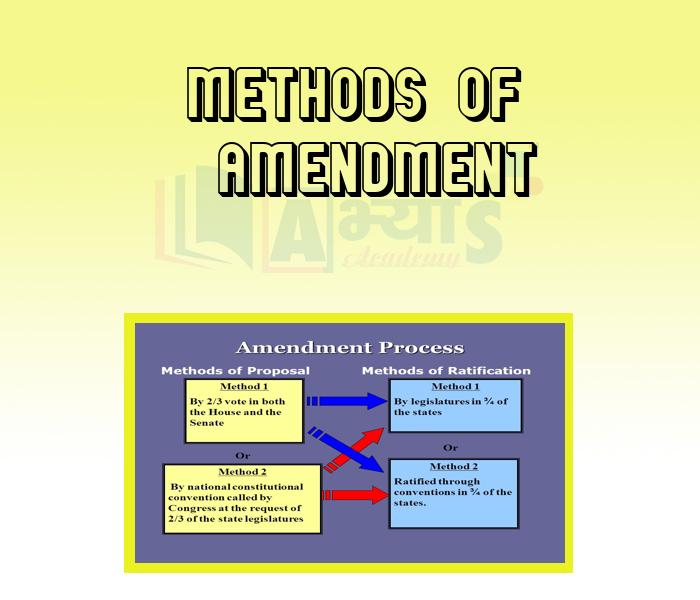Methods of Amendment










Methods of Amendment
Methods of Amendment
On paper, an amendment to the Constitution is an extremely difficult affair, and normally needs at least two-thirds of the Lok Sabha and Rajya Sabha to pass it. However, the Constitution of India is one of the most frequently amended Constitutions in the world. Many matters that would be dealt with by ordinary statutes in most democracies must be dealt with by Constitutional amendment in India due to the document's extraordinary detail. The first amendment came only a year after the adoption of the Constitution and instituted numerous minor changes. Many more amendments followed, at a rate of almost two amendments per year since 1950. Most of the Constitution can be amended after a quorum of more than half of the members of each house in Parliament passes an amendment with a two-thirds majority vote. Articles pertaining to the distribution of legislative authority between Union and State governments must also be approved by fifty percent of State legislatures.
In 1974, the Supreme Court of India in the landmark case of Kesavananda Bharati vs. the State of Kerala enunciated the Basic Structure Doctrine, which expanded the scope of judicial review to include the power to review Constitutional Amendments passed by the Legislature. Using this doctrine, the Supreme Court has struck down the 39th Amendment and parts of the 42nd Amendment as being violative of the Basic Structure of the Constitution. Some noted authors of Constitutional law, such as HM Seervai have argued that this is an usurpation of amending power by the judiciary, which was never intended by the framers of the Constitution. However, it can be argued that this doctrine is necessary to protect human rights from being abrogated simply by Constitutional amendment.
Bill can be brought for amendment of India Constitution ____________________ | |||
| Right Option : C | |||
| View Explanation | |||
Which one of the following bills is required to be passed by both Houses of the Indian Parliament separately by a special majority ? | |||
| Right Option : D | |||
| View Explanation | |||
Which of the following are correct regarding amendment of the constitution: (a) Amendment bill is passed when majority of only Lok Sabha MP's pass the amendment bill. (b) By special majority of the Parliament and ratification of at least half of the state legislatures by special majority. | |||
| Right Option : B | |||
| View Explanation | |||
Students / Parents Reviews [10]
My experience with Abhyas is very good. I have learnt many things here like vedic maths and reasoning also. Teachers here first take our doubts and then there are assignments to verify our weak points.

Shivam Rana
7thIt was good as the experience because as we had come here we had been improved in a such envirnment created here.Extra is taught which is beneficial for future.

Eshan Arora
8thOne of the best institutes to develope a child interest in studies.Provides SST and English knowledge also unlike other institutes. Teachers are co operative and friendly online tests andPPT develope practical knowledge also.

Aman Kumar Shrivastava
10thAbhyas is a complete education Institute. Here extreme care is taken by teacher with the help of regular exam. Extra classes also conducted by the institute, if the student is weak.

Om Umang
10thIt has a great methodology. Students here can get analysis to their test quickly.We can learn easily through PPTs and the testing methods are good. We know that where we have to practice

Barkha Arora
10thI have spent a wonderful time in Abhyas academy. It has made my reasoning more apt, English more stronger and Maths an interesting subject for me. It has given me a habbit of self studying

Yatharthi Sharma
10thMy experience with Abhyas academy is very good. I did not think that my every subject coming here will be so strong. The main thing is that the online tests had made me learn here more things.

Hiya Gupta
8thBeing a parent, I saw my daughter improvement in her studies by seeing a good result in all day to day compititive exam TMO, NSO, IEO etc and as well as studies. I have got a fruitful result from my daughter.

Prisha Gupta
8thAbout Abhyas metholodology the teachers are very nice and hardworking toward students.The Centre Head Mrs Anu Sethi is also a brilliant teacher.Abhyas has taught me how to overcome problems and has always taken my doubts and suppoeted me.

Shreya Shrivastava
8thA marvelous experience with Abhyas. I am glad to share that my ward has achieved more than enough at the Ambala ABHYAS centre. Years have passed on and more and more he has gained. May the centre flourish and develop day by day by the grace of God.
